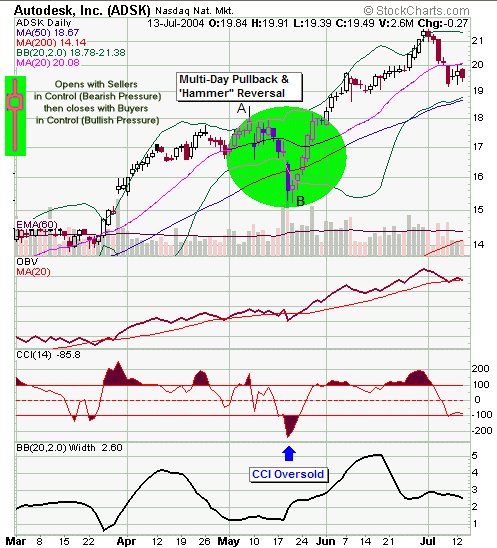TripleScreenMethod.com
The "Hammer" Candle, a High Probability Reversal Signal (01/14/05)
In tough markets like we're in now, one needs to trade low-risk technical patterns, like pullback reversals. In fact, in this environment, trading pullbacks and new 21-day lows is far less risky than trading new breakouts above pivot points, especially for TSM stocks. Before providing some historical statistics, I'll introduce the pattern and talk about its market psychology. Consider the following chart of ADSK, a current TSM stock.
As shown in the insert, the hammer candle opens the day with bears controlling of price. Selling pressure drives price down to a point where buyers step in, and bulls control into the close (and presumably over the next few days). Properly placed in a supporting area following a pullback--like candle B in the chart--they provide a springboard for a recovery move. Further, trade management criteria allow one to minimize risk (stop loss set just under the minimum and buy point just above the high). When you combine the hammer with an oversold CCI and entry below the bottom Bollinger Band, the reversal is even more probable. Throw in TSM fundamentals and value left in the price, and that's a winning recipe for profit. Note, just for the sake of completeness, the reverse of a hammer, a "hanging man" candle, operates in the same way at tops (candle A in the chart).
Before you technical purists send me an email, I know that the hammer formation I've described and shown in the chart is not ideal. By strict definition, it should have no top whisker and a bottom whisker at least three times the range of its upper body. I've expanded the definition here to increase the number of trades encountered in TSM stocks. Even so, the market psychology is the same.
The following table presents profit results for the current list of TSM stocks. For each, over a period from 1/02/04 to 1/13/05, hammer formations were identified, then the profit accrued from holding each stock until the close of the 1st through 5th day following the hammer formation calculated. In each case, a hammer was traded on the day followingits formation when the high of the hammer was exceeded under the following qualifiers: (1) minimum 3 percent pullback over preceding 4 days (measured high of hammer to high 4 days before), (2) 20-day moving average greater than 50-day moving average (insuring pullback in up trending market), (3) bottom whisker at least 4/9ths of full daily range. There were a total of 83 such hammers for this month's TSM stocks. Controls over the same period were traded when today's price exceeded yesterday's high (a higher high); they too were held 1 to 5 days.
For example, ADSK produced four hammers over the year long time frame (one of which is shown in the above chart). In total, these produced a gain of 23.59 percent when held for five days (less when held fewer days). By comparison, 123 higher highs occurred over the same time frame to produce a total gain of 311.7 percent when also held for 5 days. Average gains for the data set are summarized in the bottom rows. Generally, if one held a TSM hammer for 4 days, the return averaged 1.77 percent, 1.63 times the return of the control held 4 days. The message: hammer formations at natural reversal points offer low-risk trading opportunities.
Table of Total % Gains Following Hammer Candle and Control Higher High 1/11/05 TSM Stocks # Trades Hammer 5 day gain 4 day gain 3 day gain 2 day gain 1 day gain Control Gain 5 day 4 day gain 3 day gain 2 day gain 1 day gain # Trades ADSK 4 23.59 23.34 19.57 12.33 3.01 311.17 264.51 200.81 115.94 64.73 123 AEOS 5 5.66 2.83 5.83 6.89 0.16 104.55 78.55 66.45 54.87 9.45 112 PENN 10 35.46 38.90 40.45 21.52 8.77 178.22 167.00 174.23 114.37 46.70 105 BYD 4 -3.91 0.10 -2.67 -2.54 2.03 152.61 133.06 82.63 71.42 33.43 105 CMX 1 -6.60 -8.65 -7.40 -8.27 0.48 84.29 54.91 28.97 22.50 19.27 106 CNC 3 12.09 14.43 8.26 4.76 2.53 192.20 185.47 139.04 75.79 65.90 98 COH 3 -2.52 1.08 3.30 4.43 2.18 65.15 72.47 65.53 51.65 45.67 101 CTSH 3 9.63 1.54 -12.55 -4.68 -2.46 161.40 108.41 80.56 64.41 39.41 99 DHI 1 -4.56 -6.30 -3.94 -4.03 1.58 27.71 21.45 14.31 25.92 37.90 96 EV 0 0.00 0.00 0.00 0.00 0.00 102.69 87.67 63.96 48.47 26.15 125 HOV 4 13.96 11.90 10.84 -0.74 -2.41 41.94 12.60 20.99 34.37 20.30 100 INFY 5 20.18 18.57 8.51 7.38 7.08 103.56 98.63 70.83 46.03 28.69 109 KBH 3 -1.55 1.53 1.60 -0.44 2.04 96.03 73.57 48.86 62.31 56.37 90 NTAP 4 16.76 18.69 12.45 5.84 5.63 178.59 179.91 147.66 98.59 56.69 99 PSYS 5 -7.00 -3.80 -6.28 -1.48 7.81 163.55 118.48 82.71 46.84 25.04 99 RIO 2 7.89 4.47 -0.40 1.80 1.89 214.93 190.58 147.28 108.39 88.67 105 RYL 2 -4.87 -8.68 -3.81 -1.47 -0.37 91.03 67.10 55.70 80.27 47.00 98 SFCC 3 23.54 28.98 22.09 16.32 1.79 167.77 133.20 110.63 68.16 56.24 105 SRX 4 -8.43 -2.06 -2.91 -0.43 2.17 109.70 87.70 73.37 54.17 48.39 103 TOL 1 0.48 -1.20 -1.05 0.85 -0.05 132.14 96.33 60.88 68.04 51.87 96 TTC 3 1.58 2.34 0.53 1.64 1.48 119.78 107.03 76.67 48.64 30.96 103 URBN 4 -11.43 -9.14 -5.36 -0.06 1.53 158.92 133.96 86.83 64.10 28.17 113 UTIW 8 16.14 20.17 21.28 16.47 7.60 146.56 114.94 86.66 59.73 30.56 101 WLP 1 -2.74 -1.74 -0.60 -0.40 -0.59 111.37 138.21 95.31 79.79 29.86 107 Average Return: 1.61 1.77 1.30 0.91 0.65 1.29 1.09 0.83 0.63 0.40 TSM/Control Ratio: 1.25 1.63 1.56 1.46 1.64
